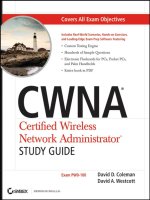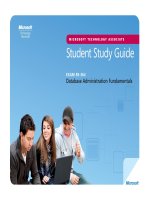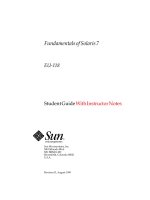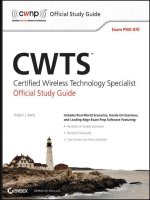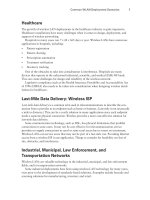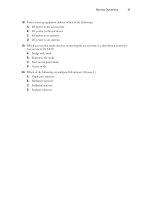cwts certified wireless technology specialist official study guide exam pw0 070 phần 1 ppt
Bạn đang xem bản rút gọn của tài liệu. Xem và tải ngay bản đầy đủ của tài liệu tại đây (682.16 KB, 51 trang )
CWTS
TM
Certified Wireless
Technology Specialist
Official Study Guide
Robert J. Bartz
38893ffirs.indd 1 5/18/09 4:06:02 PM
Acquisitions Editor: Jeff Kellum
Development Editor: Stef Jones
Technical Editors: Bryan Harkins and Marcus Burton
Production Editor: Rachel McConlogue
Copy Editor: Lunaea Hougland
Production Manager: Tim Tate
Vice President and Executive Group Publisher: Richard Swadley
Vice President and Publisher: Neil Edde
Media Project Manager 1: Laura Moss-Hollister
Media Associate Producer: Angie Denny
Media Quality Assurance: Josh Frank
Book Designers: Judy Fung and Bill Gibson
Compositor: Craig W. Johnson, Happenstance Type-O-Rama
Proofreader: Publication Services, Inc.
Indexer: Nancy Guenther
Project Coordinator, Cover: Lynsey Stanford
Cover Designer: Ryan Sneed
Copyright © 2009 by Wiley Publishing, Inc., Indianapolis, Indiana
Published simultaneously in Canada
ISBN: 978-0-470-43889-3
No part of this publication may be reproduced, stored in a retrieval system or transmitted in any form or by any
means, electronic, mechanical, photocopying, recording, scanning or otherwise, except as permitted under Sections
107 or 108 of the 1976 United States Copyright Act, without either the prior written permission of the Publisher, or
authorization through payment of the appropriate per-copy fee to the Copyright Clearance Center, 222 Rosewood
Drive, Danvers, MA 01923, (978) 750-8400, fax (978) 646-8600. Requests to the Publisher for permission
should be addressed to the Permissions Department, John Wiley & Sons, Inc., 111 River Street, Hoboken, NJ
07030, (201) 748-6011, fax (201) 748-6008, or online at />Limit of Liability/Disclaimer of Warranty: The publisher and the author make no representations or warranties
with respect to the accuracy or completeness of the contents of this work and specifically disclaim all warran-
ties, including without limitation warranties of fitness for a particular purpose. No warranty may be created or
extended by sales or promotional materials. The advice and strategies contained herein may not be suitable for
every situation. This work is sold with the understanding that the publisher is not engaged in rendering legal,
accounting, or other professional services. If professional assistance is required, the services of a competent pro-
fessional person should be sought. Neither the publisher nor the author shall be liable for damages arising herefrom.
The fact that an organization or Web site is referred to in this work as a citation and/or a potential source of
further information does not mean that the author or the publisher endorses the information the organization or
Web site may provide or recommendations it may make. Further, readers should be aware that Internet Web sites
listed in this work may have changed or disappeared between when this work was written and when it is read.
For general information on our other products and services or to obtain technical support, please contact
our Customer Care Department within the U.S. at (877) 762-2974, outside the U.S. at (317) 572-3993 or fax
(317) 572-4002.
Wiley also publishes its books in a variety of electronic formats. Some content that appears in print may not be
available in electronic books.
Library of Congress Cataloging-in-Publication Data
Bartz, Robert J., 1959-
CWTS : certified wireless technology specialist official study guide (PW0-070) / Robert J. Bartz. — 1st ed.
p. cm.
ISBN-13: 978-0-470-43889-3 (pbk.)
ISBN-10: 0-470-43889-4 (pbk.)
1. Wireless LANs—Examinations—Study guides. 2. Telecommunications engineers—Certification—Study
guides. I. Title. II. Title: Certified wireless technology specialist official study guide (PW0-070).
TK5105.78.B37 2009
621.384076—dc22
2009010840
TRADEMARKS: Wiley, the Wiley logo, and the Sybex logo are trademarks or registered trademarks of John
Wiley & Sons, Inc. and/or its affiliates, in the United States and other countries, and may not be used without
written permission. CWTS is a trademark of CWNP, Inc. All other trademarks are the property of their respec-
tive owners. Wiley Publishing, Inc., is not associated with any product or vendor mentioned in this book.
10 9 8 7 6 5 4 3 2 1
38893ffirs.indd 2 5/18/09 4:06:03 PM
Disclaimer: This eBook does not include ancillary media
that was packaged with the printed version of the book.
Dear Reader,
Thank you for choosing CWTS: Certified Wireless Technology Specialist Official Study
Guide. This book is part of a family of premium-quality Sybex books, all of which are
written by outstanding authors who combine practical experience with a gift for teaching.
Sybex was founded in 1976. More than thirty years later, we’re still committed to produc-
ing consistently exceptional books. With each of our titles we’re working hard to set a
new standard for the industry. From the paper we print on to the authors we work with,
our goal is to bring you the best books available.
I hope you see all that reflected in these pages. I’d be very interested to hear your com-
ments and get your feedback on how we’re doing. Feel free to let me know what you think
about this or any other Sybex book by sending me an email at , or if you
think you’ve found a technical error in this book, please visit .
Customer feedback is critical to our efforts at Sybex.
Best regards,
Neil Edde
Vice President and Publisher
Sybex, an Imprint of Wiley
38893ffirs.indd 3 5/18/09 4:06:03 PM
To my mother Kathryn, who taught me and my 11 brothers and sisters the
meaning of hard work, honesty, and loyalty. At 86 years young she is still a
great inspiration to me. I want to say thanks, Mom.
38893ffirs.indd 4 5/18/09 4:06:03 PM
Acknowledgments
I would like to thank my wife, Jeannie, and two young adult children, Ashley and Jason,
and to say how much I appreciate the support I received during the writing process of this
book. This book was a huge task that took hundreds of hours and kept me locked away for
days at a time. They made completing this project much easier for me because of their sup-
port, patience, and understanding.
I would also like to thank all the people at Sybex who helped with the creation of this
book, including Acquisitions Editor Jeff Kellum, Production Editor Rachel McConlogue,
Copy Editor Lunaea Hougland, Editorial Assistant Connor O’Brien and Editorial Manager
Pete Gaughan. I owe all these individuals a ton of gratitude for their patience while work-
ing with me on this project, including having to deal with a few unexpected delays.
A very special thanks goes to the Development Editor Stef Jones for all her hard work in
helping me with the editing, organization, and suggestions that allowed me to complete this
book and still maintain my sanity. Her knowledge, expertise, and attention to detail were
an enormous help to me.
The Technical Editor of this book is Bryan Harkins. I want to thank Bryan for his timely
reviews, comments, and suggestions that helped make this book a valuable reference source
for sales and technical support people. His years of experience as a technical trainer, engi-
neer, and security specialist were a great contribution in creating a book I hope you will
enjoy reading.
I would like to thank the thousands of students who have taken the time to attend the net-
working classes I was given the opportunity to teach. Educating, mentoring, and entertaining
so many of these individuals gave me the inspiration and motivation to author this book.
Of course, this book would not exist if it were not for the people at CWNP. This group
of individuals I have known for many years includes Kevin Sandlin, Scott Williams, Devin
Akin, and Scott Turner as well as some of the newer members of the team, Cary Chandler,
Marcus Burton, Trish Bruce, Abbey Cole, and all the others. They have realized the need
for vendor-neutral wireless LAN training and certification and have done a great job of
building a brand over the years that is now known worldwide.
Finally, a thank you to all the manufacturers, vendors, organizations, and individuals
that provided the subject matter, allowing me the technology and tools needed to write
this book.
Aerohive –
www.aerohive.com
Stephen Philip and Adam Conway
AirMagnet –
www.airmagnet.com
Joe Kuo and Dilip Advani
Aruba Networks –
www.arubanetworks.com
Brad Day and Michael Tennefoss
Broadcom Corporation –
www.broadcom.com
Cisco Systems – www.cisco.com
38893ffirs.indd 5 5/18/09 4:06:03 PM
CompactFlash Association – www.compactflash.org
CWNP –
www.cwnp.com
Devin Akin and Marcus Burton
HP ProCurve (Colubris Networks) –
www.procurve.com
IEEE – www.ieee.org
Intel – www.intel.com
L-com Global Connectivity – www.l-com.com
Jim Corcoran
Linksys –
www.linksys.com
MetaGeek – www.metageek.net
Mark Jensen and Ryan Woodings
Motorola –
www.motorola.com
Tim Brophy and Bryan Harkins
Netgear –
www.netgear.com
Network Stumbler – www.netstumbler.com
PCI-SIG – www.pcisig.com
PCMCIA Association –
www.pcmcia.org
Mary Hain, Hain Communications
Proxim Wireless –
www.orinocowireless.com
Psiber Data Systems – www.psiber.com
Bruce Nelson
SD Association –
www.sdcard.org
TamoSoft – www.tamos.com
Michael Berg
TerraWave Solutions –
www.terrawave.com
Jennifer Haltom
Trapeze Networks –
www.trapezenetworks.com
USB Implementers Forum, Inc. – www.usb.org
Wi-Fi Alliance –
www.wi-fi.org
WildPackets – www.wildpackets.com
Xirrus – www.xirrus.com
Douglas Haider
38893ffirs.indd 6 5/18/09 4:06:03 PM
About the Author
Robert Bartz is a technical trainer and computer networking consultant. He is a graduate
of California State University Long Beach, School of Engineering, with a Bachelor of Science
degree in Industrial Technology. Prior to becoming a computer networking engineer and
trainer, Robert was employed as an aerospace test engineer working with radar systems
and satellite communications. He has attained many technical certifications over the years,
including Master Certified Novell Engineer (MCNE), Certified Novell Instructor (CNI),
Microsoft Certified Systems Engineer (MCSE), Microsoft Certified Trainer (MCT), CWNP
Certified Wireless Network Administrator (CWNA), Certified Wireless Security Profes-
sional (CWSP), and Certified Wireless Network Trainer (CWNT), to name a few. He has
been involved with the CWNP program since its inception and has taught this technology
to thousands of people from various industries and markets across the United States and
abroad.
Robert is the founder of Eight-O-Two Technology Solutions, LLC, a computer network-
ing technical training and consulting services company providing education and services to
various organizations both local and around the country. He spends his spare time learning
new technology, working outside, and enjoying the beauty of his surroundings at his home
in Monument, Colorado. Robert hopes one day to semi-retire and be the proprietor of a
neighborhood eating and drinking establishment in a warm sunny beach community. He
can be contacted by e-mail at
38893ffirs.indd 7 5/18/09 4:06:03 PM
Contents at a Glance
Foreword xxi
Introduction xxiii
Assessment Test xxxvi
Chapter
1 Introduction to Wireless Local Area Networking 1
Chapter
2 Wireless LAN Infrastructure Devices 27
Chapter
3 Wireless LAN Client Devices 61
Chapter
4 Radio Frequency (RF) Fundamentals for
Wireless LAN Technology 95
Chapter
5 Access Methods, Architectures, and
Spread Spectrum Technology 131
Chapter
6 WLAN Antennas and Accessories 159
Chapter
7 WLAN Terminology and Technology 205
Chapter
8 Planning a WLAN Site Survey 249
Chapter
9 Performing a WLAN Site Survey 283
Chapter
10 WLAN Security 337
Chapter
11 Troubleshooting and Maintaining Wireless Networks 381
Appendix About the Companion CD 421
Glossary 427
Index 445
38893ffirs.indd 8 5/18/09 4:06:04 PM
Contents
Foreword xxi
Introduction xxiii
Assessment Test xxxvi
Chapter
1 Introduction to Wireless Local Area Networking 1
Common WLAN Deployment Scenarios 3
Small Office/Home Office (SOHO) 4
Enterprise Deployments: Corporate Data Access
and End-User Mobility 4
Extending Existing Networks with Wireless LAN 5
Mobile Office and Public Wireless Hotspots 5
Educational Institutions: Classroom Deployments 6
Healthcare 7
Last-Mile Data Delivery: Wireless ISP 7
Industrial, Municipal, Law Enforcement, and
Transportation Networks 7
Building-to-Building Connectivity 8
Radio Frequency Regulatory Domain Governing Bodies 9
United States: Federal Communications Commission (FCC) 10
Europe: European Telecommunications Standards
Institute (ETSI) 11
IEEE and Wireless LAN Standards 11
802.11 11
802.11b 12
802.11a 12
802.11g 13
802.11n 14
Additional IEEE 802.11 Amendments 16
Interoperability Certifications 16
Wi-Fi Alliance 17
Wi-Fi Protected Access (WPA) Certification Overview 17
Wi-Fi Protected Access 2 (WPA 2.0) Certification Overview 18
Wi-Fi Multimedia (WMM) Certification Overview 18
Wi-Fi Multimedia Power Save (WMM-PS) Certification
Overview 19
Wi-Fi Protected Setup (WPS) Certification Overview 19
Summary 20
38893ftoc.indd 9 5/18/09 4:05:53 PM
x
Contents
Key Terms 20
Exam Essentials 21
Review Questions 22
Answers to Review Questions 26
Chapter
2 Wireless LAN Infrastructure Devices 27
OSI Model Basics 28
Access Points (AP) 29
Autonomous Access Points 31
Lightweight Access Points 38
Mesh Access Points 38
Wireless LAN Routers 40
Wireless Bridges 42
Wireless Repeaters 42
Wireless LAN Controller/Switch 43
Power over Ethernet (PoE) 47
Summary 51
Exam Essentials 52
Key Terms 53
Review Questions 54
Answers to Review Questions 58
Chapter
3 Wireless LAN Client Devices 61
PCMCIA 62
Features of PCMCIA Cards 63
Installation and Configuration of PCMCIA Cards 64
ExpressCard 68
Features of the ExpressCard 68
Installation and Configuration of an ExpressCard 69
USB 1.0, USB 1.1, and USB 2.0 69
Features of USB 70
Installation and Configuration of USB Devices 71
CompactFlash (CF) Devices 73
Features of CF Cards 73
Installation and Configuration of a CF Card 74
Secure Digital (SD) 74
Features of SDIO Cards 75
Installation and Configuration of SDIO Cards 75
Peripheral Component Interconnect (PCI) 75
Features of PCI 76
Installation and Configuration of PCI Cards 77
38893ftoc.indd 10 5/18/09 4:05:53 PM
Contents
xi
Mini-PCI and Mini-PCIe (Mini-PCI Express) 79
Features of Mini-PCI and Mini-PCIe Cards 79
Installation and Configuration of Mini-PCI and
Mini-PCIe Cards 80
Workgroup Bridges 81
Features of Workgroup/Client Bridges 82
Installation and Configuration of Workgroup/Client Bridges 83
Client Device Drivers 83
Client Utility Software 84
Manufacturer-Specific Client Utilities 85
Third-Party Client Utilities 86
Summary 86
Exam Essentials 87
Key Terms 88
Review Questions 89
Answers to Review Questions 93
Chapter
4 Radio Frequency (RF) Fundamentals for
Wireless LAN Technology 95
Understanding Radio Frequency (RF) 96
Wavelength 98
Frequency 99
Amplitude 100
Phase 100
Frequencies Used for Wireless LANs 101
Coverage and Capacity 104
Coverage 105
Capacity 108
Channel Reuse and Co-location 109
RF Range and Speed 110
Line of Sight 111
Interference 112
Environment: RF Behavior 114
Basic Units of RF Measurement 118
Absolute Measurements of Power 118
Relative Measurements of Power 119
Summary 122
Exam Essentials 122
Key Terms 123
Review Questions 124
Answers to Review Questions 128
38893ftoc.indd 11 5/18/09 4:05:53 PM
xii
Contents
Chapter
5 Access Methods, Architectures, and
Spread Spectrum Technology 131
Network Access Methods 132
Detecting Network Traffic Collisions with CSMA/CD 133
Avoiding Network Traffic Collisions with CSMA/CA 134
Reserving Time for Data Transmission Using
Distributed Coordination Function (DCF) 135
Effects of Half Duplex on Wireless Throughput 135
Narrowband vs. Spread Spectrum Communication 136
Spread Spectrum Technology 138
Frequency-Hopping Spread Spectrum (FHSS) 138
Direct-Sequence Spread Spectrum (DSSS) 140
High Rate/Direct-Sequence Spread Spectrum (HR/DSSS) 140
DSSS and HR/DSSS Channels 141
Orthogonal Frequency Division Multiplexing (OFDM) 143
OFDM Channels 144
Multiple Input/Multiple Output (MIMO) 146
MIMO Channels 147
Co-location of HR/DSSS and ERP-OFDM Systems 147
Adjacent-Channel and Co-channel Interference 148
WLAN/WPAN Coexistence 148
Summary 150
Exam Essentials 151
Key Terms 152
Review Questions 153
Answers to Review Questions 157
Chapter
6 WLAN Antennas and Accessories 159
Basic RF Antenna Concepts 160
RF Lobes 161
Beamwidth 161
Antenna Gain 163
Passive Gain 164
Active Gain 165
Antenna Polarization 166
WLAN Antenna Types 167
Omnidirectional Antennas 167
Omnidirectional Antenna Specifications 168
Semidirectional Antennas 170
Highly Directional Antennas 181
Highly Directional Antenna Specifications 182
38893ftoc.indd 12 5/18/09 4:05:53 PM
Contents
xiii
RF Cables and Connectors 184
Cable Types 184
Cable Length 184
Cable Cost 185
Impedance and VSWR 186
RF Connectors 186
Factors in Antenna Installation 187
Addressing the Effects of Earth Curvature 187
Antenna Placement 187
Minimizing the Effects of Multipath Using
Antenna Diversity 188
Combating Effects of Wind and Lightning on
Wireless Connections 190
Lightning Arrestors 190
Grounding Rods 191
Installation Safety 191
Antenna Mounting 191
Pole/Mast Mount 192
Ceiling Mount 193
Wall Mount 194
Maintaining Clear Communications 194
Visual Line of Sight 194
RF Line of Sight 194
Fresnel Zone 194
Summary 195
Exam Essentials 196
Key Terms 197
Review Questions 198
Answers to Review Questions 202
Chapter
7 WLAN Terminology and Technology 205
Wireless LAN Modes of Operation 206
Independent Basic Service Set (IBSS) 207
Basic Service Set (BSS) 212
Extended Service Set (ESS) 214
Connecting to a Wireless Network 216
Frame Types 216
Passive Scanning 217
Active Scanning 218
Authentication 219
Association 223
Deauthentication and Disassociation 224
38893ftoc.indd 13 5/18/09 4:05:54 PM
xiv
Contents
Distribution System (DS) 225
Data Rates 226
Throughput 228
Dynamic Rate Switching (DRS) 231
WLAN Roaming 232
Power Saving Operation 234
Active Mode (AM) 234
Power Save (PS) Mode 234
Automatic Power Save Delivery (APSD) 236
Protection Mechanisms 236
Extended Rate Physical (ERP) Protection Mechanism 236
High Throughput (HT) Protection Mechanism 237
Summary 239
Exam Essentials 241
Key Terms 242
Review Questions 243
Answers to Review Questions 247
Chapter
8 Planning a WLAN Site Survey 249
Wireless LAN Site Surveys 250
Size of Physical Location 251
Intended Use of the Network 251
Number of Users 251
Performance Expectations 252
Gathering Business Requirements 252
General Office/Enterprise 253
Manufacturing 254
Warehousing 256
Retail/Point of Sale (POS) 257
Health Care/Medical 257
Government/Military 259
Education 260
Public Access, Hotspots, Hospitality 261
Interviewing Managers and Users 262
Manufacturer Guidelines and Deployment Guides 265
Defining Physical and Data Security Requirements 265
Gathering Site-Specific Documentation 266
Floor Plans and Blueprints 266
Furnishings 266
Electrical Specifications 267
Documenting Existing Network Characteristics 267
Identifying Infrastructure Connectivity and Power Requirements
268
38893ftoc.indd 14 5/18/09 4:05:54 PM
Contents
xv
Understanding RF Coverage and Capacity Requirements 270
Client Connectivity Requirements 270
Antenna Use Consideration 271
Summary 274
Exam Essentials 275
Key Terms 275
Review Questions 276
Answers to Review Questions 280
Chapter
9 Performing a WLAN Site Survey 283
The Physical Site Survey Process 285
RF Spectrum Analysis 286
Wi-Fi and Non-Wi-Fi Interference Sources 289
Wi-Fi Interference 294
Performing a Manual Site Survey 299
Obtaining a Floor Plan or Blueprint 300
Identifying Existing Wireless Networks 300
Testing Access Point Placement 301
Analyzing the Results 303
Advantages and Disadvantages of Manual Site Survey 303
Software Assisted Manual Site Survey 303
Manual Site Survey Toolkit 306
Performing a Predictive Site Survey 307
Protocol Analysis 312
Documenting Existing Network Characteristics 318
RF Coverage Requirements 319
Infrastructure Hardware Selection and Placement 320
Infrastructure Connectivity and Power Requirements 320
Received Signal Strength 321
Antenna Use Considerations 323
Testing Multiple Antenna Types 323
Choosing the Correct Antennas 324
Channel Architectures 325
Multiple Channel Architecture (MCA) 326
Single Channel Architecture (SCA) 326
Installation Limitations 327
Site Survey Report 328
Summary 328
Exam Essentials 329
Key Terms 330
Review Questions 331
Answers to Review Questions 335
38893ftoc.indd 15 5/18/09 4:05:54 PM
xvi
Contents
Chapter
10 WLAN Security 337
Introduction to Wireless Security 339
Wireless LAN Threats and Intrusion 339
IEEE 802.11 Standards Security 341
Open System Authentication 341
Shared Key Authentication 342
Early WLAN Security Mechanisms 342
Service Set Identifier (SSID) 343
SSID Hiding 343
Media Access Control (MAC) Address 344
Authentication and Encryption 346
About Wired Equivalent Privacy (WEP) 346
How to Use WEP 346
SOHO and Enterprise Security Solutions 348
PIN-Based or Push-Button Configuration (PBC)
Wireless Security 348
PIN-Based Security 348
Push-Button Configuration (PBC) Security 348
Passphrase-Based Security 350
Passphrase Features 351
User-Based Security 351
802.1X 352
EAP 353
802.1X/EAP 353
Remote Authentication Dial In User Service 354
Encryption: WEP/TKIP/CCMP 356
WEP 356
TKIP 357
CCMP 359
Role-Based Access Control (RBAC) 360
Virtual Private Networking (VPN) 360
PPTP 362
L2TP 363
Components of a VPN Solution 363
Wireless Intrusion Prevention Systems (WIPS) 367
Regulatory Compliance 369
PCI Compliance 369
HIPAA Compliance 370
Other Regulatory Compliances 370
Summary 371
Exam Essentials 372
Key Terms 373
Review Questions 374
Answers to Review Questions 378
38893ftoc.indd 16 5/18/09 4:05:54 PM
Contents
xvii
Chapter
11 Troubleshooting and Maintaining
Wireless Networks 381
Identifying Wireless LAN Problems 382
Transmitters and Receivers 384
No Connectivity 384
Intermittent Connectivity 390
Throughput 394
Software and Hardware Upgrades 398
Optimizing Wireless Networks 404
Infrastructure Hardware Selection and Placement 405
Identifying, Locating, and Removing Sources
of Interference 405
Client Load Balancing 406
Analyzing Infrastructure Capacity and Utilization 407
Multipath 408
Hidden Node 408
Summary 412
Exam Essentials 413
Key Terms 413
Review Questions 414
Answers to Review Questions 418
Appendix About the Companion CD 421
What You’ll Find on the CD 422
Demonstration Software Programs 422
Demonstration Software Programs
Available for Download 423
Case Studies 423
Case Studies Available for Download 424
Generic Floor Plan 424
Applications 424
Sensor Placement Site Survey Form 424
Sybex Test Engine 424
Electronic Flashcards 425
System Requirements 425
Using the CD 425
Troubleshooting 426
Customer Care 426
Glossary 427
Index 445
38893ftoc.indd 17 5/18/09 4:05:54 PM
38893flast.indd 18 5/19/09 5:57:47 AM
Table of Exercises
Exercise
3.1 PCMCIA Card Installation Steps 65
Exercise
3.2 Installing a USB 2.0 Wireless LAN Adapter 71
Exercise
3.3 PCI Card Installation Steps 77
Exercise
3.4 Mini-PCI and Mini-PCIe Installation Steps 81
Exercise
4.1 How to Demonstrate Fresnel Zone and Blockage 111
Exercise
6.1 Demonstrate Passive Gain 165
Exercise
6.2 Steps for Installing a Pole/Mast Mount 193
Exercise
7.1 How to Measure Throughput of a Wireless Network 229
Exercise
9.1 Spectrum Analysis Demonstration 290
Exercise
9.2 PC Card Spectrum Analyzer Demonstration 294
Exercise
9.3 Predictive Site Survey Demonstration 309
Exercise
9.4 Protocol Analyzer Demonstration 314
Exercise
10.1 VPN Setup 364
Exercise
11.1 Upgrading a Device Driver 399
38893flast.indd 19 5/19/09 5:57:47 AM
38893flast.indd 20 5/19/09 5:57:47 AM
Foreword
Manufacturers, value added resellers (VARs), and end-user organizations are now seeing
the value of training and certifying not only “techies,” but account managers, sales repre-
sentatives, project managers, help desk professionals, and others with similar roles on Wi-Fi
technology. For maximum ROI, it’s important that this Wi-Fi training and certification be
appropriate to these specific job roles. The Wi-Fi landscape is continually changing, and
keeping abreast of trends, terminology, and technology has never been more important.
With all of this change, how can an organization be sure to train and certify its people on
relevant and position-appropriate material? How can an organization provide an upwardly
mobile learning path should its people change positions? How can an organization be sure
that the training being provided to its people will continue to be relevant should they decide
to partner with a different or additional vendor? These are valid concerns faced by large
organizations every day, and CWNP has the answer. CWNP’s new Certified Wireless
Technology Specialist (CWTS™) certification has been targeted at these user groups with
the modus operandi “what it is, not how it works.” For example, in most organizations it’s
clear that a Wi-Fi account manager needs to understand what an RF site survey is and why
it’s important in given circumstances, but it’s also clear why the account manager doesn’t
need to understand every nuance of performing an RF site survey in order to accomplish his
or her own sales functions. The same applies to a plethora of topics, from understanding
Wi-Fi equipment types to Wi-Fi security.
Wi-Fi terminology is a world of confusion in and of itself, but the confusion can be greatly
reduced with even a minimal amount of targeted education. It doesn’t help that marketing
departments at various manufacturers create a new marketing term for every new technol-
ogy offering, often changing their own terminology for the purpose of differentiation. Most
technologies, devices, equipment features, architectures, and the like have industry-standard
names. Such standardized naming conventions are facilitated by the IEEE, Wi-Fi Alliance,
and by CWNP. For example, when implementing a single channel architecture (a term that
also has various marketing terms in the industry) system, each channel is called a
.
This could be a span, stack, layer, blanket, channel, or perhaps something new in the near
future. They all mean the same thing. How is the customer to compare apples-to-apples
when Wi-Fi terminology is all over the map? This is where trained people make all the
difference.
The book you now hold in your hand is an important step in studying for the CWTS
certification. The CWTS: Certified Wireless Technology Specialist Official Study Guide
covers the CWTS exam objectives step-by-step in a concise manner. It’s a no-nonsense
approach to obtaining a certification that will differentiate you from your peers and help
you wins sales, better support your customers, and most of all, grow in your career.
Robert Bartz has been part of the CWNP program since day 1, when in our very first
class in November 2001 he sat front-left paying close attention while I was explaining RF
behavior. Thereafter, he very quickly passed the CWNA exam and moved on to become
one of our first instructors. He has participated in CWNP in a variety of ways over the
38893flast.indd 21 5/19/09 5:57:47 AM
xxii
Foreword
years and has added significant value to the program as a whole. He has taught CWNP
classes at every level and to diverse audiences around the globe since 2001, and it’s easy to
give both Robert and his new book a big thumbs-up. I would also like to thank Sybex for
producing such high-quality books for CWNP. They are a class act through and through,
and we look forward to working with them more in the future. Now, what are you waiting
for? Stop reading this foreword, and get on to Chapter 1. Your future in Wi-Fi awaits!
Devin Akin
Chief Technology Officer
The CWNP Program
38893flast.indd 22 5/19/09 5:57:47 AM
Introduction
xxiii
Introduction
This book is intended to provide an introduction to the exciting and emerging world of
wireless LAN technology. This technology continues to expand at a phenomenal pace with
constant improvements in speed, reliability, and security. Reading this book will teach you
the fundamentals of standards-based technology, giving you an overview of the design,
communication, hardware components, and maintenance associated with wireless LAN
technology, commonly referred to as Wi-Fi™.
In addition to providing an overview of the technology, this book will help you prepare
for the Certified Wireless Technology Specialist (CWTS) certification exam available from
the CWNP program. CWTS is an entry-level enterprise wireless LAN certification, and is
recommended prior to the Certified Wireless Network Administrator (CWNA) certifica-
tion. CWTS is designed as a replacement for the Wireless# Certification. This certification
is geared specifically toward both wireless LAN (WLAN) sales and support staff for those
in the enterprise WLAN industry.
Not only will this book help you prepare for the CWTS Certification exam, it will give
you the fundamental knowledge, tools, and terminology to more effectively sell and support
enterprise WLAN technologies. The main goal of this book is for you to learn “what it is,”
not “how it works.” The “how” part comes later in other CWNP Study Guides and instructor-
led courses. After reading this book and completing all the available practice exam tools
included, you will have the knowledge needed to take the CWTS certification exam.
Finally, the CD included with this book contains evaluation software you can install in
order to become familiar with RF spectrum analysis, perform some limited packet analysis,
and explore site survey tools.
For more information about the CWTS and other vendor-neutral wireless LAN certifica-
tions from the CWNP program, visit
www.cwnp.com.
About CWNP
®
CWNP is the abbreviation for Certified Wireless Network Professional and is the industry
standard for vendor-neutral, enterprise wireless LAN certifications. CWNP currently offers
five levels of enterprise WLAN certifications, from novice to expert. The goal of CWNP is
to provide educational resources and certifications that are recognized worldwide to infor-
mation technology (IT) and sales professionals in the field of wireless networking technol-
ogy. By acquiring this knowledge, these professionals will be able to enter any business and
sell, design, install, manage, and support the wireless LAN infrastructure regardless of
which manufacturer’s solution is used.
In addition to CWTS, there are four other wireless certifications currently offered
from CWNP:
CWNA
®
: Certified Wireless Network Administrator The CWNA
®
(Certified Wireless
Network Administrator) certification is the foundation-level enterprise wireless LAN cer-
tification for the CWNP program. The CWNA certification will validate one’s skills to
38893flast.indd 23 5/19/09 5:57:47 AM
xxi v
Introduction
successfully administer enterprise-class wireless LANs. Passing the CWNA exam will earn
one credit toward the more advanced CWNP certifications. The CWNA exam measures
one’s ability to understand the fundamentals of RF behavior and to describe the features
and functions of various WLAN components. Passing the PW0-104, Wireless LAN Admin-
istration certification exam will satisfy the requirement to become CWNA certified.
CWSP
®
: Certified Wireless Security Professional The CWSP
®
(Certified Wireless Security
Professional) certification is an advanced-level WLAN certification offered by the CWNP
program. Acquiring this certification will prove one’s ability to successfully apply the most
up-to-date wireless LAN security solutions to an organization’s wireless LAN. This certifi-
cation will ensure that the successful candidate understands the security weaknesses inher-
ent in wireless LANs, the solutions available to address those weaknesses, and the steps
necessary to implement a secure and manageable wireless LAN in an enterprise environ-
ment. Successfully passing two exams is required to become CWSP certified:
Exam PW0-104 – Wireless LAN Administration
Exam PW0-200 – Wireless LAN Security
CWNE
®
: Certified Wireless Network Expert The CWNE
®
credential is the final certifica-
tion step in the CWNP program. By successfully completing the CWNE requirements, one
will have demonstrated that they have the most advanced skills available in today’s wire-
less LAN market. CWNE assures that the skills mastered include the ability to administer,
install, configure, troubleshoot, and design wireless network systems. Additional skills
include protocol analysis, intrusion detection and prevention, performance and QoS analy-
sis, spectrum analysis, and WLAN management.
In order to become CWNE certified, one must pass the PW0-104, PW0-200, and PW0-300
exams, and hold a valid CWSP certification at the time of application for CWNE. Success-
fully passing these exams is not all that is required. To maintain CWNE certification, the
following criteria must be met:
Pass all three exams, PW0-104, PW0-200, and PW0-300
Professional experience
Three letters of endorsement
60 points in the CWNE points schedule
Continuing education requirement
For additional information on the details required for CWNE certification,
visit
www.cwnp.com
CWNT
®
: Certified Wireless Network Trainer Certified Wireless Network Trainers
(CWNT
®
) are qualified instructors certified by the CWNP program to deliver CWNP
training courses to IT professionals. CWNTs are technical and instructional experts in
38893flast.indd 24 5/19/09 5:57:48 AM
